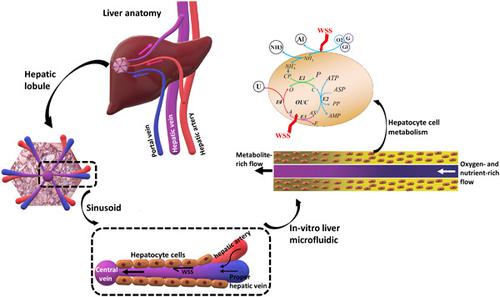当前位置:
X-MOL 学术
›
Biotechnol. Bioeng.
›
论文详情
Our official English website, www.x-mol.net, welcomes your
feedback! (Note: you will need to create a separate account there.)
A mechanobiological mathematical model of liver metabolism.
Biotechnology and Bioengineering ( IF 3.5 ) Pub Date : 2020-06-05 , DOI: 10.1002/bit.27451 Mohammad R Nikmaneshi 1, 2 , Bahar Firoozabadi 1 , Lance L Munn 2
Biotechnology and Bioengineering ( IF 3.5 ) Pub Date : 2020-06-05 , DOI: 10.1002/bit.27451 Mohammad R Nikmaneshi 1, 2 , Bahar Firoozabadi 1 , Lance L Munn 2
Affiliation

|
The liver plays a complex role in metabolism and detoxification, and better tools are needed to understand its function and to develop liver‐targeted therapies. In this study, we establish a mechanobiological model of liver transport and hepatocyte biology to elucidate the metabolism of urea and albumin, the production/detoxification of ammonia, and consumption of oxygen and nutrients. Since hepatocellular shear stress (SS) can influence the enzymatic activities of liver, the effect of SS on the urea and albumin synthesis are empirically modeled through the mechanotransduction mechanisms. The results demonstrate that the rheology and dynamics of the sinusoid flow can significantly affect liver metabolism. We show that perfusate rheology and blood hematocrit can affect urea and albumin production by changing hepatocyte mechanosensitive metabolism. The model can also simulate enzymatic diseases of the liver such as hyperammonemia I, hyperammonemia II, hyperarginemia, citrollinemia, and argininosuccinicaciduria, which disrupt the urea metabolism and ammonia detoxification. The model is also able to predict how aggregate cultures of hepatocytes differ from single cell cultures. We conclude that in vitro perfusable devices for the study of liver metabolism or personalized medicine should be designed with similar morphology and fluid dynamics as patient liver tissue. This robust model can be adapted to any type of hepatocyte culture to determine how hepatocyte viability, functionality, and metabolism are influenced by liver pathologies and environmental conditions.
中文翻译:

肝脏代谢的力学生物学数学模型。
肝脏在代谢和解毒中起着复杂的作用,需要更好的工具来了解其功能并开发肝脏靶向疗法。在这项研究中,我们建立了肝脏运输和肝细胞生物学的机械生物学模型,以阐明尿素和白蛋白的代谢、氨的产生/解毒以及氧气和营养物质的消耗。由于肝细胞剪切应力 (SS) 会影响肝脏的酶活性,因此 SS 对尿素和白蛋白合成的影响是通过机械转导机制经验建模的。结果表明,正弦流的流变学和动力学可以显着影响肝脏代谢。我们表明,灌注液流变学和血液血细胞比容可以通过改变肝细胞机械敏感性代谢来影响尿素和白蛋白的产生。该模型还可以模拟肝脏的酶性疾病,如高氨血症 I、高氨血症 II、高精氨酸血症、瓜氨酸血症和精氨琥珀酸尿症,这些疾病会破坏尿素代谢和氨解毒。该模型还能够预测肝细胞的聚集培养物与单细胞培养物的不同之处。我们得出的结论是,用于肝脏代谢研究或个性化医疗的体外可灌注装置的设计应具有与患者肝脏组织相似的形态和流体动力学。这种强大的模型可适用于任何类型的肝细胞培养,以确定肝细胞的活力、功能和代谢如何受到肝脏病理和环境条件的影响。瓜氨酸血症和精氨琥珀酸尿症,它们会破坏尿素代谢和氨解毒。该模型还能够预测肝细胞的聚集培养物与单细胞培养物的不同之处。我们得出的结论是,用于肝脏代谢研究或个性化医疗的体外可灌注装置的设计应具有与患者肝脏组织相似的形态和流体动力学。这种强大的模型可适用于任何类型的肝细胞培养,以确定肝细胞的活力、功能和代谢如何受到肝脏病理和环境条件的影响。瓜氨酸血症和精氨琥珀酸尿症,它们会破坏尿素代谢和氨解毒。该模型还能够预测肝细胞的聚集培养物与单细胞培养物的不同之处。我们得出的结论是,用于肝脏代谢研究或个性化医疗的体外可灌注装置的设计应具有与患者肝脏组织相似的形态和流体动力学。这种强大的模型可适用于任何类型的肝细胞培养,以确定肝细胞的活力、功能和代谢如何受到肝脏病理和环境条件的影响。我们得出的结论是,用于肝脏代谢研究或个性化医疗的体外可灌注装置的设计应具有与患者肝脏组织相似的形态和流体动力学。这种强大的模型可适用于任何类型的肝细胞培养,以确定肝细胞的活力、功能和代谢如何受到肝脏病理和环境条件的影响。我们得出的结论是,用于研究肝脏代谢或个性化医疗的体外可灌注装置应设计为具有与患者肝脏组织相似的形态和流体动力学。这种强大的模型可适用于任何类型的肝细胞培养,以确定肝细胞的活力、功能和代谢如何受到肝脏病理和环境条件的影响。
更新日期:2020-08-14
中文翻译:

肝脏代谢的力学生物学数学模型。
肝脏在代谢和解毒中起着复杂的作用,需要更好的工具来了解其功能并开发肝脏靶向疗法。在这项研究中,我们建立了肝脏运输和肝细胞生物学的机械生物学模型,以阐明尿素和白蛋白的代谢、氨的产生/解毒以及氧气和营养物质的消耗。由于肝细胞剪切应力 (SS) 会影响肝脏的酶活性,因此 SS 对尿素和白蛋白合成的影响是通过机械转导机制经验建模的。结果表明,正弦流的流变学和动力学可以显着影响肝脏代谢。我们表明,灌注液流变学和血液血细胞比容可以通过改变肝细胞机械敏感性代谢来影响尿素和白蛋白的产生。该模型还可以模拟肝脏的酶性疾病,如高氨血症 I、高氨血症 II、高精氨酸血症、瓜氨酸血症和精氨琥珀酸尿症,这些疾病会破坏尿素代谢和氨解毒。该模型还能够预测肝细胞的聚集培养物与单细胞培养物的不同之处。我们得出的结论是,用于肝脏代谢研究或个性化医疗的体外可灌注装置的设计应具有与患者肝脏组织相似的形态和流体动力学。这种强大的模型可适用于任何类型的肝细胞培养,以确定肝细胞的活力、功能和代谢如何受到肝脏病理和环境条件的影响。瓜氨酸血症和精氨琥珀酸尿症,它们会破坏尿素代谢和氨解毒。该模型还能够预测肝细胞的聚集培养物与单细胞培养物的不同之处。我们得出的结论是,用于肝脏代谢研究或个性化医疗的体外可灌注装置的设计应具有与患者肝脏组织相似的形态和流体动力学。这种强大的模型可适用于任何类型的肝细胞培养,以确定肝细胞的活力、功能和代谢如何受到肝脏病理和环境条件的影响。瓜氨酸血症和精氨琥珀酸尿症,它们会破坏尿素代谢和氨解毒。该模型还能够预测肝细胞的聚集培养物与单细胞培养物的不同之处。我们得出的结论是,用于肝脏代谢研究或个性化医疗的体外可灌注装置的设计应具有与患者肝脏组织相似的形态和流体动力学。这种强大的模型可适用于任何类型的肝细胞培养,以确定肝细胞的活力、功能和代谢如何受到肝脏病理和环境条件的影响。我们得出的结论是,用于肝脏代谢研究或个性化医疗的体外可灌注装置的设计应具有与患者肝脏组织相似的形态和流体动力学。这种强大的模型可适用于任何类型的肝细胞培养,以确定肝细胞的活力、功能和代谢如何受到肝脏病理和环境条件的影响。我们得出的结论是,用于研究肝脏代谢或个性化医疗的体外可灌注装置应设计为具有与患者肝脏组织相似的形态和流体动力学。这种强大的模型可适用于任何类型的肝细胞培养,以确定肝细胞的活力、功能和代谢如何受到肝脏病理和环境条件的影响。











































 京公网安备 11010802027423号
京公网安备 11010802027423号